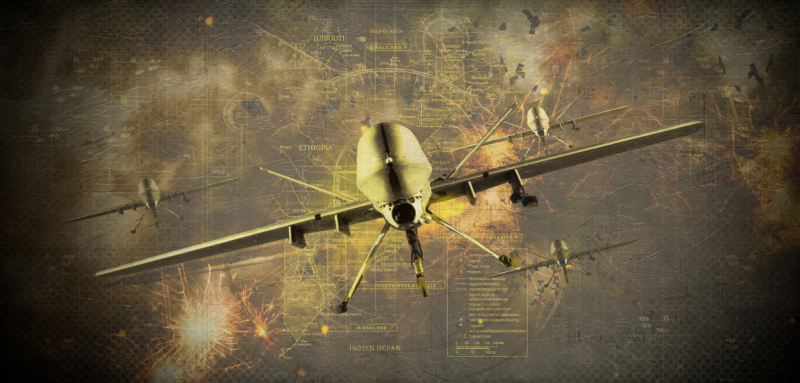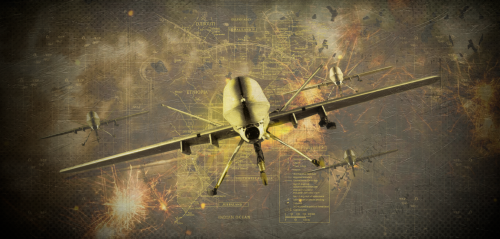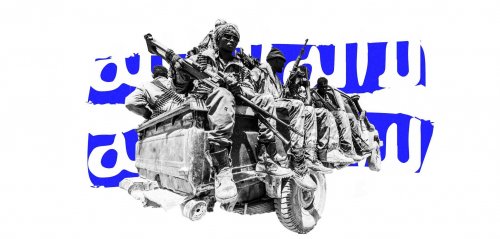After years of ebb and flow of war between the Somali government and the fundamentalist al-Qaeda-affiliated movement al-Shabaab, drones from several countries allied with Somalia have entered the battlefield. The drones have played a significant role in helping the government, which is supported by African Union forces, rapidly reclaim extensive areas of central and southern Somalia.
These drones altered the course of the war—a traditional conflict that had been fluctuating between battlefield gains and setbacks. The war was being fought between two sides nearly equal in terms of human capital and weapons. Within a short period, it transformed into a conflict in which one side faced an opponent with modern and advanced weapons capable of striking from afar without direct engagement. This boosted the morale of the Somali army and the popular forces—the Ma'awisley forces—supporting it. It also simultaneously undermined the military capabilities of al-Shabaab, due to the heavy losses it suffered in personnel and equipment as a result of the continuous drone strikes on its leaders and military bases.
In this report, Raseef22 delves into the entry of drones into the ongoing battles in Somalia, as well as their origins, objectives, and role in bolstering the Somali government's position. Moreover, this report also analyzes the collateral damage inflicted on civilians as a consequence of targeting terrorists.
These drones altered the course of the war—a traditional conflict that had been fluctuating between battlefield gains and setbacks. The war was being fought between two sides nearly equal in terms of human capital and weapons. Within a short period, it transformed into a conflict in which one side faced an opponent with modern and advanced weapons capable of striking from afar without direct engagement.
Drones enter the battlefield
The appearance and impact of drones in the war in Somalia have varied depending on the nature and scale of their operations and roles, reflecting the differing agendas and interests of the countries deploying them.
A knowledgeable Somali security source who spoke on the condition of anonymity disclosed to Raseef22 that airstrikes carried out by foreign aircraft in the country trace back to the emergence of al-Shabaab. They cited the killing of the movement's founding leader, Aden Hashi Ayro, in 2008. However, the era of drones—also known as uncrewed aerial vehicles—began in 2012 following the election of the current Somali President Hassan Sheikh Mohamud during his first presidential term. It is important to note that the activities and operations they carried out were initially limited and focused on targeting al-Shabaab leaders wanted by the United States.
The source highlights that during this period, drones, and particularly American ones, successfully eliminated several key leaders of al-Shabaab. The most notable examples were the movement's second-in-command, Khalifa Ayro Ahmed Abdi Godane, killed in 2014, and Lebanese al-Qaeda liaison Bilal al-Berjawi, targeted by a US drone in 2012.
With the beginning of President Hassan Sheikh Mohamud's second term in mid-2022, the frequency of drone attacks in Somalia escalated. New countries, including Turkey and the UAE, joined the fight and began actively coordinating with the Somali army. This led to substantial victories in the war.
With the beginning of President Hassan Sheikh Mohamud's second term in mid-2022 and after he declared an expanded military campaign against al-Shabaab, the frequency of drone attacks in Somalia escalated. New countries, including Turkey and the United Arab Emirates (UAE), joined the fight and began actively coordinating with the Somali army. This collaboration significantly bolstered the government forces and allied tribal militias, leading to substantial victories in the war.
The drones provided crucial aerial support to the Somali army, disrupting the balance of power that had initially favored al-Shabaab in terms of weaponry and logistics. This was particularly evident amid Somalia's arms embargo, lifted only at the end of 2023. Thus, drones became a decisive advantage for the army, contributing to the defeat and expulsion of al-Shabaab from extensive areas.
Our efforts to contact several government sources regarding al-Shabaab's potential possession of drones and the government forces' reliance on them were unsuccessful. All official sources declined to comment, citing their preference as “a matter of national sovereignty.”
Headquarters and sources
Although Somalia's airspace is open to countries that militarily support Mogadishu, three countries actively deploy drones in Somalia: Turkey, the UAE, and the United States. The three conduct their activities through coordination with relevant Somali authorities under the pretext of combating terrorism.
Washington has been active in Somalia for some time under the pretext of deterring terrorism, not only through drones but also across various security sectors. The drones used are likely the MQ-9 Reaper, manufactured by the United States. Turkey utilizes Bayraktar TB2 drones, manufactured by the Turkish company Baykar and known for their effectiveness in offensive and reconnaissance roles on the battlefield. Moreover, the Turkish drones coordinate more closely with Somali authorities.
It is confirmed that the UAE has used Bayraktar TB2 drones at least once, alongside drones manufactured by other countries. Compared with the United States and Turkey, it is clear the UAE conducted fewer drone operations. Security and political relations between Somalia and the UAE began to decline after a suicide bombing that killed Emirati officers and employees in Mogadishu. Bilateral relations have deteriorated due to a variety of factors, including Abu Dhabi's support for Puntland President Said Deni, a rival of current President Hassan Sheikh Mohamud. Emirati support enabled Deni to win a second term to lead the state in January 2024.
With Emirati drones scaling back, Turkish drones have ramped up their operations. This especially took place after Turkey was granted a military and economic protection contract for the Somali coast in February 2024. Somali security expert Abdul Aziz Ahmed Ali explains to Raseef22 that American drones are deployed from their naval vessels in the Red Sea and Indian Ocean or operate from their command base (AFRICOM) in Djibouti, overseen through collaboration with their Somali proxies. He adds that Turkish drones take off from their base in Mogadishu, while Emirati drones originate from bases in the state of Puntland, northeast Somalia.
Due to limited information on drone types, their offensive capabilities, and launch sites before airstrikes, reliable details remain sparse. Raseef22’s security source reports drones feature two main types: reconnaissance units that gather intel on militant locations, strengths, and numbers; and attack units, which engage in targeting and striking al-Shabab fighters, their convoys, and barracks. Attack units act under high command and direct guidance from reconnaissance units.
A key to successive victories
Drones have notably operated in Sheikh Mahmud’s recent operations against al-Shabaab, working directly and openly with the army. The army has particularly used Turkish drones, whose control headquarters are located in Mogadishu. They conduct necessary reconnaissance operations to monitor al-Shabaab positions and affiliated intelligence, executing preemptive strikes against the movement's defenses. This enhanced army performance and led to the army securing rapid ground victories across multiple fronts.
Some incidents "amount to war crimes"... Even though foreign drones have helped turn the tide against al-Shabaab, they have inflicted serious damages and losses on civilians. How can this be mitigated?
In this context, Ahmed Ali emphasizes that drones have played an active role in the war against al-Shabaab. Drones have crucially contributed to the Somali army’s successive victories on the ground, targeting the movement’s leadership, gathering intelligence on their positions, destroying defenses and headquarters, and neutralizing their weaponry and armored vehicles from afar.
The benefit of drones was on full display when the army and allied forces breached al-Shabaab fortified defenses and tunnels in several cities in the Middle Shabelle and Hiran provinces. Although these fortifications aimed to impede army advances and prevent them from establishing control, they did not shield al-Shabaab elements from drone strikes, forcing them to flee without engaging the army. The example underscores the importance of drones in countering the insurgency and supporting the army in retaining liberated areas and capturing new territories.
The security source notes that military operations halted due to the distance between the control base of Turkish drones in Mogadishu—which leads in total launched airstrikes—and the frontlines, which have moved approximately 300 kilometers from the capital to the fronts of Hirshabelle and Galmudug. Consequently, ground forces have become ineffective in executing their tasks in those areas. He also highlights ongoing efforts by the Somali government to establish control centers in the Hiran, Middle Shabelle, and Galguduud provinces to resume operations and liberate territories in Galmudug and Hirshabelle from militant control.
It is worth mentioning that drones focused their operations during the initial phase of the military campaign on Middle Shabelle and Hiran, demolishing defenses, fortifications, and trenches erected by al-Shabaab in several cities to defend them. This facilitated the army and its allies' occupation of these cities and towns without fierce confrontations with the militants.
In the latest developments in the war on terrorism and the use of foreign drones, President Sheikh Mohamud made a two-day visit last week to the town of Wargati in Middle Shabelle province, located about 250 kilometers north of Mogadishu. The purpose was to inspect and supervise activities related to establishing a military base that includes several facilities, such as a drone command center and a military operations command center for the upcoming second phase of the war. The next phase is expected to commence soon in the country, and aims to liberate remaining central areas under al-Shabaab's grip.
Significant damage and civilian casualties
When discussing active drones in Somalia, it is not all positive achievements and gains. There are painful aspects too involving their implication in crimes against civilians, ranging from killings, injuries, and property destruction under the pretext of pursuing terrorist elements. Over recent years, Somalia has witnessed numerous incidents of indiscriminate drone strikes on remote towns and villages, resulting in the deaths and injuries of at least dozens of civilians.
At varying periods, reports from local and international organizations, including Amnesty International, have accused United States Africa Command (AFRICOM) and Turkey of blatant violations of international humanitarian law due to civilian deaths and injuries in Somalia, asserting that actions by international drones affecting civilians could amount to "war crimes." Somali media has repeatedly shown families and individuals confirming the deaths and injuries of their loved ones, demanding compensation for their losses.
Some residents of remote areas under the control of al-Shabaab lose their lives, suffer injuries, or see their property destroyed in attacks carried out by foreign drones targeting the fundamentalist group. The Somali government does not appear to investigate these incidents or take any measures with its allies operating these drones to prevent civilian casualties in the future or compensate those already affected.
In its latest report on violations by foreign drones in Somalia, Amnesty International confirmed that 23 civilians—including 14 children, 5 women, and 4 men—were killed in a strike by a Turkish drone on a farm on March 18, 2024. The farm is located about 3 kilometers west of Bagdad, near Afgoye in the province Lower Shabelle. Additionally, another strike injured 17 additional civilians, including 11 children, 2 women, and 4 men.
It is noteworthy that the families of the victims of drone strikes have received no compensation whatsoever, nor have any of the injured been compensated. This is attributed by some to the "failure of the federal government" to act and pressure the drone-owning or -operating countries to respond to the demands of the victims' families and compensate them. The Somali government does not appear to have taken any transparent investigative actions regarding these incidents or implemented measures to prevent their recurrence in the future.
We were unable to reach any of the affected families living in remote areas. These families face difficult circumstances and compounded suffering under al-Shabaab control.
Somali human rights activist Abdullah Ali believes the problem of repeated civilian casualties from airstrikes and the government's failure to compensate victims stems from a lack of clear understanding between it and the countries owning the drones. There is no official agreement regulating the operation of drones in the country that safeguard the rights of Somali citizens in case of violations against them. He points out that this flaw has led the government to remain silent on such events or merely announce investigations without presenting any results.
Security expert Ahmed Ali adds that regardless of the positive role drones have played in military operations against al-Shabab, the damages and losses on civilians remain a significant challenge for the present and future. Ahmed Ali does not rule out that these recurring incidents may amount to war crimes if the government does not change course in these operations, or it does not provide necessary reparations to the families of civilian victims.
Raseef22 is a not for profit entity. Our focus is on quality journalism. Every contribution to the NasRaseef membership goes directly towards journalism production. We stand independent, not accepting corporate sponsorships, sponsored content or political funding.
Support our mission to keep Raseef22 available to all readers by clicking here!
Interested in writing with us? Check our pitch process here!







